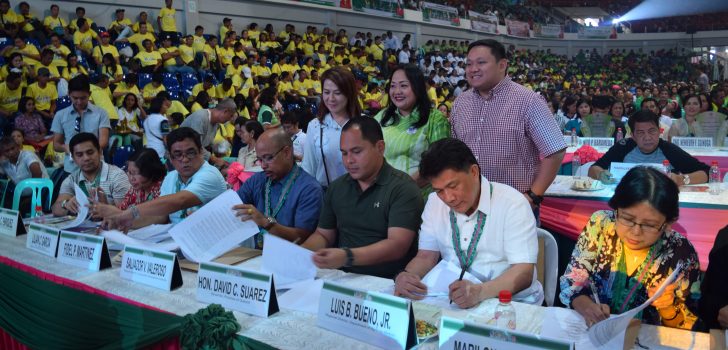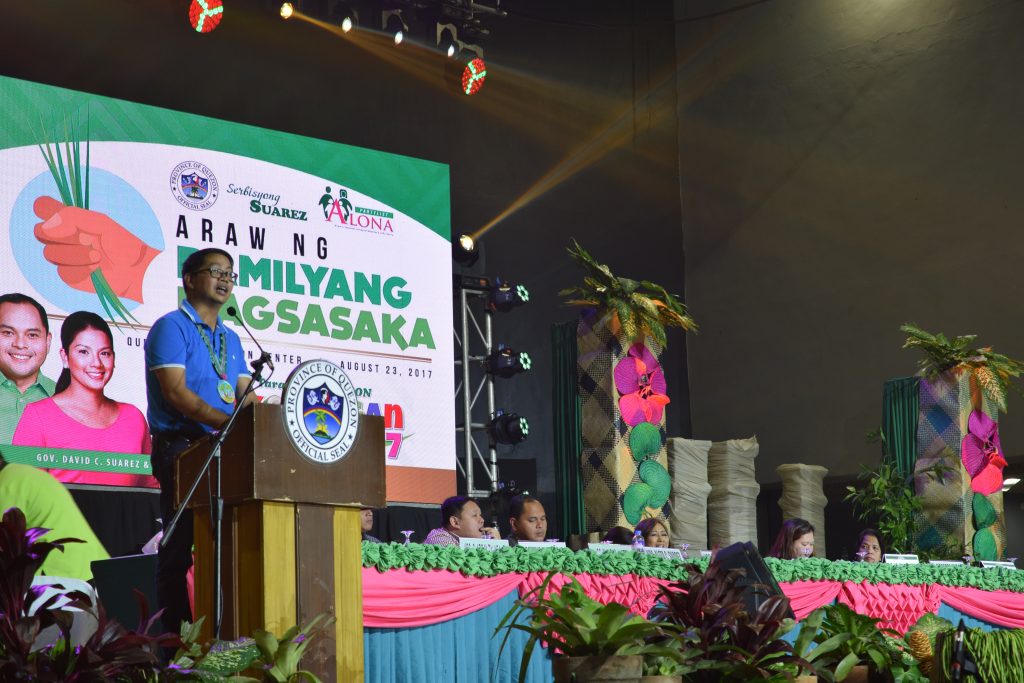 Heads and representatives of the Department of Agriculture (DA), DA attached agencies, other government agencies, and the academe come out in full support during the signing of the Memorandum of Understanding for the mainstreaming of the Quezon PCIP.
Heads and representatives of the Department of Agriculture (DA), DA attached agencies, other government agencies, and the academe come out in full support during the signing of the Memorandum of Understanding for the mainstreaming of the Quezon PCIP. Quezon gets the ball rolling for interagency convergence
Since 2011, the Niyugniyugan Festival celebrates the best of the agricultural industry of Quezon Province. This 10-day long festivity allocates one whole day, dubbed as the Araw ng Pamilyang Magsasaka, for farmers, fisherfolk, and their families.
This year, during their special day, the farmers and fisherfolk of Quezon witnessed the signing of the Memorandum of Understanding (MOU) among representatives of key offices for the interagency convergence and mainstreaming of the Provincial Commodity Investment Plan (PCIP) to improve the province’s agricultural sector.
“Kayo ang bumubuhay sa ating lalawigan. Kaya naman karapat-dapat lamang na ang planong binuo para sa inyong industriya ay maisabuhay at inyong mapakinabangan (You are the ones who keep enriching our province. That is why it is only fitting that the plan we developed for your industries [agriculture and fisheries] will be implemented for you to enjoy its benefits),” Quezon Governor David Suarez said to the farmer associations and cooperatives present during the activity.
The Quezon Province leads the CALABARZON Region in terms of the number of subprojects under the Philippine Rural Development Project (PRDP). This may be attributed to the province’s larger agricultural production area compared to the other provinces in the region. The seven approved priority commodities with value chain analyses (VCAs) for the region have been included in Quezon’s PCIP. The commodities included are coconut, seaweeds, dairy cattle, banana, cacao, mango, and pineapple. The VCAs for approval and those in the pre-final editing will also be included.
“The PCIP serves as the platform for convergence. Because of the MOU signing, the provincial government and different government agencies are now bound to shell out investment and support for projects identified in the PCIP within the next three years,” PRDP South Luzon Project Support Office (PSO) local and national level planning (I-PLAN) Component Head Rey Lara said.
Department of Agriculture (DA) CALABARZON Regional Executive Director Arnel De Mesa also emphasized the relevance of embedding PCIPs in the regular activities of each partner agency in promoting good governance. Since the needs and opportunities for each commodity are already identified and included in the PCIP, the government projects and programs to be implemented will be in line with the areas that are in need of assistance.

Department of Agriculture CALABARZON Regional Executive Director Arnel de Mesa shares the good news for the farmers of Quezon Province on behalf of Undersecretary Ariel Cayanan. He also revealed that the province will soon have more enterprise and infrastructure subprojects under PRDP in the pipeline.
Every three months, a convergence meeting chaired by the provincial governor will be conducted to discuss the partner agencies’ programs and projects that the LGUs in Quezon can avail of. The Provincial Planning and Development Office (PPDO) will serve as the over-all secretariat for this initiative.
Governor Suarez together with DA-RFO Director De Mesa led the MOU signing for the PCIP mainstreaming and convergence. Other government agencies and institutions represented during the activity were the Department of Agrarian Reform, Department of Trade and Industry, Department of Science and Technology, Department of Environment and Natural Resources, Philippine Crop Insurance Corporation, Philippine Coconut Authority, Agricultural Training Institute, and the Bureau of Fisheries and Aquatic Resources. Representatives of the Agricultural Credit and Policy Council, Philippine Fiber Industry Development Authority, Bureau of Agricultural Research, Cooperative Development Authority, Bureau of Soils and Water Management, Bureau of Plant Industry, National Dairy Authority, Fertilizer and Pesticide Authority, National Irrigation Administration, Land Bank of the Philippines, and South Luzon State University were also present.
According to CALABARZON Regional Project Coordination Office (RPCO) I-PLAN Component Head Ella Obligado, the MOU signing for the remaining provinces in the region will be conducted before the year ends. ### (Lawrence Albert Bariring, DA-PRDP CALABARZON RPCO InfoACE Unit)
